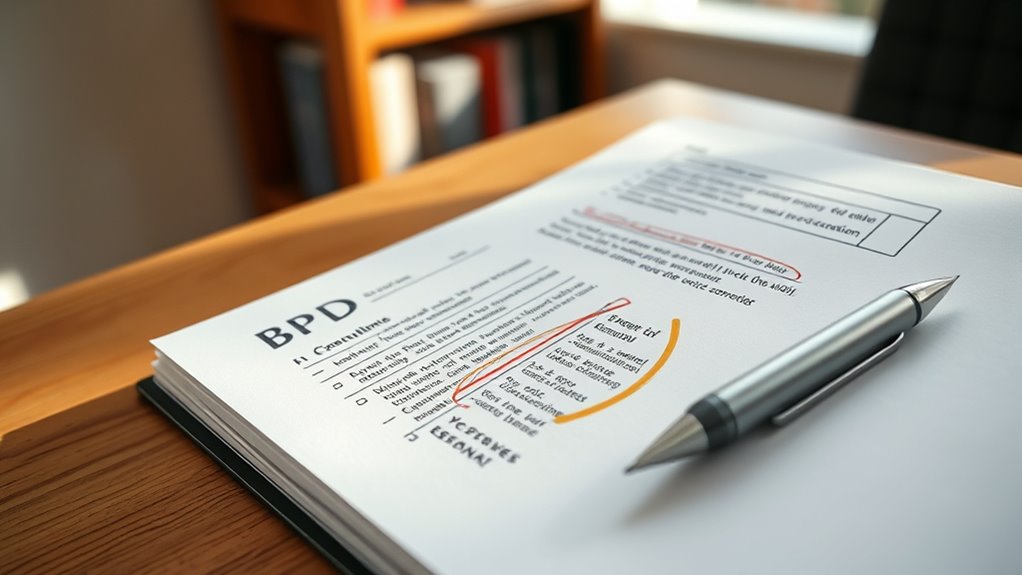The DSM‑5‑TR outlines clear criteria for diagnosing borderline personality disorder, focusing on patterns of unstable relationships, self-image, and emotions. You’ll need to show at least five symptoms, like fear of abandonment, impulsivity, and emotional swings that last for at least six months. These behaviors are consistent across different situations and cause significant distress or impairment. If you want to understand how clinicians identify BPD, there’s more to explore behind these guidelines.
Key Takeaways
- Diagnosis requires at least five of nine specific criteria, including unstable relationships, self-image, emotions, and impulsivity.
- Symptoms must persist for six months or more and cause significant distress or impairment.
- Key features include intense fear of abandonment, emotional swings, impulsive behaviors, and feelings of emptiness.
- Assessment involves interviews, clinical observation, and possibly input from loved ones to identify consistent behavioral patterns.
- The goal of diagnosis is to understand individual experiences, guide targeted support, and improve overall functioning.

Have you ever wondered how professionals determine if someone has Borderline Personality Disorder (BPD)? It all starts with a careful assessment based on established criteria. The DSM‑5‑TR, or Diagnostic and Statistical Manual of Mental Disorders, Fifth Edition, Text Revision, provides a clear framework for diagnosing BPD. When clinicians evaluate you, they look for specific patterns of behavior, emotions, and relationships that align with these criteria. They don’t rely on a single symptom but rather on a combination that persists over time and causes significant distress or impairment.
The core of the diagnosis involves observing whether you display a pervasive pattern of instability in your interpersonal relationships, self-image, and emotions. For example, they might ask about your experiences with intense fear of abandonment, feeling empty, or having difficulty controlling anger. These symptoms are common in BPD, but they need to be present consistently and across different contexts. The clinician will also explore whether your impulsivity affects your life, such as reckless spending, unsafe sex, or substance abuse. These behaviors aren’t isolated incidents but part of a broader pattern that has been ongoing for at least six months.
Your mental health professional will also assess if you experience significant mood swings or intense emotional reactions that seem disproportionate to the situation. They might inquire about episodes of depression, irritability, or anxiety that last for hours or days. It’s important to note that these emotional fluctuations are often rapid and can feel overwhelming. Additionally, they’ll look at your sense of self—whether you have a fluctuating or unstable self-image that impacts your goals, values, or sense of identity. This volatility often contributes to relationship problems and internal turmoil.
Emotional fluctuations can be rapid, overwhelming, and impact your sense of self and relationships.
Furthermore, understanding the role of AI-driven data analytics can help clinicians better track and interpret behavioral patterns over time, supporting accurate diagnosis and personalized treatment planning.
To make an accurate diagnosis, clinicians use specific criteria outlined in the DSM‑5‑TR. They need to confirm that at least five of these criteria are met, and these symptoms interfere with your daily functioning. The process involves a detailed interview, sometimes supplemented by questionnaires or reports from loved ones, to gather a thorough picture of your behavior across different settings. Remember, diagnosing BPD isn’t about labeling but understanding your experiences so that you can access appropriate support and treatment. It’s about recognizing patterns and helping you find ways to manage symptoms effectively. The goal is to clarify your struggles so that you can work toward stability, improved relationships, and a better quality of life.
Frequently Asked Questions
Can BPD Symptoms Change Over Time?
Yes, your BPD symptoms can change over time. With proper treatment, therapy, and support, you might notice improvements in emotional stability, relationships, and coping skills. Some symptoms may lessen or become less intense, while others might fluctuate depending on life circumstances or stress levels. Remember, progress varies for everyone, so staying consistent with your treatment plan and seeking help when needed can lead to positive changes.
How Accurate Is a BPD Diagnosis?
Approximately 75% of people with BPD receive an accurate diagnosis, but it can still be challenging due to symptom overlap with other disorders. Your diagnosis is generally dependable when a mental health professional conducts a thorough assessment, including clinical interviews and history. Keep in mind, symptoms can fluctuate, which might occasionally affect accuracy. Regular follow-ups and open communication ensure your diagnosis remains as precise and helpful as possible.
Are There Cultural Differences in BPD Diagnosis?
Yes, there are cultural differences in diagnosing BPD. You might find that symptoms are interpreted differently depending on cultural norms and expressions of emotion. In some cultures, intense emotional reactions are more acceptable, which can lead to underdiagnosis or misdiagnosis. It’s important for mental health professionals to take cultural context into account to ensure accurate diagnosis and appropriate treatment, avoiding biases that could impact your understanding and care.
What Is the Success Rate of BPD Treatment?
Think of treatment success like planting a seed that grows steadily. You have about a 50-70% chance of significant improvement with therapy, especially dialectical behavior therapy (DBT). Consistent effort, strong support, and commitment help this seed flourish. While setbacks happen, many find lasting relief, transforming emotional storms into calmer waters. Your dedication and the right treatment can turn challenges into opportunities for growth and resilience.
How Does BPD Coexist With Other Mental Health Conditions?
You might notice that BPD often coexists with conditions like depression, anxiety, or substance abuse. When these overlap, it can make diagnosis and treatment more intricate. You should work closely with your mental health professional to develop a thorough plan that addresses all issues. Managing each condition simultaneously helps improve your overall well-being and reduces the impact of these comorbidities on your daily life.
Conclusion
Understanding BPD diagnosis through DSM-5-TR criteria is like revealing a complex puzzle—you gain clarity and insight into yourself or others. With this knowledge, you can navigate the stormy seas of emotional turmoil more confidently, recognizing patterns and seeking help when needed. Remember, just as a lighthouse guides ships safely to shore, understanding these criteria lights your way toward better mental health and support. Embrace this knowledge; it’s your compass through the storm.









